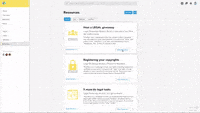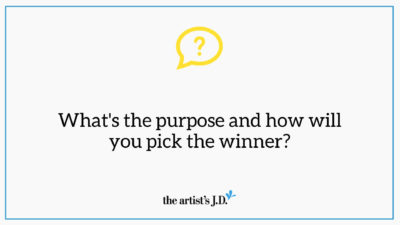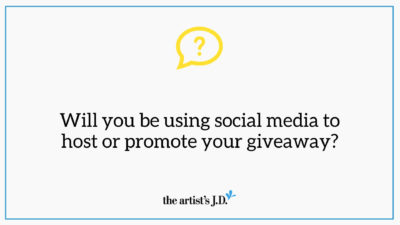If you are like most creative business owners, you’ve hosted a giveaway or two. But did you know that there were laws (and platform terms of service) your giveaway must comply with to be legal?
Most creatives don’t (and in fact, I’d say that 90% of the giveaways I see don’t follow the rules I’ll outline below).
So that you stand out from the pack, I’m breaking down the five steps necessary to not only host a giveaway that complies with the laws but also actually helps you grow your business)!
What is a legit giveaway?
I don’t like to rely on scare tactics to convince you that you should do things on the legal up and up.
And even if I did, when it comes to giveaways scare tactics are pointless because it’s rare that a business gets in trouble for hosting an illegal giveaway.
So why should you go through the extra steps of creating a giveaway that’s on the legal up and up?
There are three big reasons I think you should comply with the rules:
- Because it’ll force you to slow down and create a giveaway that doesn’t grow vanity metrics but grows your business
- You’ll save yourself stress when the sponsor emails asking you for these things
- The legal requirements aren’t that hard to comply with
So how do you host a legal giveaway?
There are five steps to hosting a legal giveaway. These steps are:
- Decide the purpose and how will you pick the winner
- Decide if you will be using social media to host or promote your giveaway
- Create a free way to enter that has the same chances of winning (if picking a random winner)
- Create the rules for your giveaway
- Promote and host your giveaway
Watch the short version…
Do you prefer to watch? You are in luck! I break down the steps of hosting a giveaway on the legal up and up in this video.
Want help hosting a legal giveaway?

Great news! There’s a course in the artist’s Courtyard that walks you through the process step-by-step.
In the course, you’ll also find six legal giveaway examples (including Official Rules) so you can quickly create your giveaway!
5 steps to hosting a legal giveaway
Are you a reader (or just want more details)? I’ve got you covered with the full scoop on how to do each of these steps below.
Step 1: Decide the purpose and how will you pick the winner

Your giveaway shouldn’t exist in a vacuum. It should exist so that it propels your business towards your goals. And so the first step in hosting a legal giveaway is to think about why you are hosting it and how you’ll select your winner.
Why are you hosting a giveaway?
You should have a strategy or plan around why you are hosting your giveaway.
This goal will then determine how you set up your giveaway. Your goal might be to:
- increase email subscribers
- grow your Instagram following
- sell a specific product
And ideally, your giveaway goal should be tied to things that generate revenue for your business. (Because if you aren’t generating revenue, you aren’t going to be in business long.)
For example, your goal should be to:
- grow Instagram followers if you know that an engaged Instagram following allows you to charge more for sponsored posts
- grow your email list if you know that your email list is your biggest source of product sales
- nurture relationships with your Facebook Group if you know that 10% of them will buy everything you offer
Your goal shouldn’t be to increase a vanity metric if it also isn’t something that helps you generate revenue.
How will you pick the winner?
In legalese, there are three kinds of giveaways:
- lottery: prize + random winner + something of value
- sweepstakes: prize + random winner + nothing of value
- contests: prize + not a random winner + something of value
And as business owners, we are only allowed to host the last two (sweepstakes and contests).
For now, all you need to decide if the goals of your giveaway line up with picking a random winner or hand-picking your winner.
- If your goal is to get as many entrants as possible and make it easy for them to enter by following you, commenting, or signing up for your list, you might pick a random winner
- If your goal is to increase awareness of your high-priced product, course, or mastermind then you might want to make sure the winner is someone that is a good fit. So you might want to have an application and hand-pick your winner.
If you pick a random winner, then you’ll need to read Step 3 in detail so you don’t make the mistake that 99% of Instagram giveaways make.
If you decide to hand-pick your winner, then you’ll have to create judging criteria that you’ll use to select your winner. (For example, creativity, financial need, the ability of the program to help them, etc.)
Step 2: Decide if you will be using social media to host or promote your giveaway

Remember those terms of service that you agreed to (but never read) when you created your Pinterest, Instagram, Facebook, or YouTube account?
Buried in those terms are additional rules about how you must host your giveaway.
So when you host or promote a giveaway on social media, you have to obey the laws, plus the service’s rules.
For example, Meta says that if you are hosting a giveaway on Instagram you:
- cannot inaccurately tag content or encourage users to inaccurately tag (they give the example of encouraging people to tag themselves in a photo when they aren’t in it.)
- must have each entrant release Instagram from any liability for participating
- must state that the promotion is in no way sponsored, endorsed, administered by, or associated with Instagram.
Luckily, they make it fairly easy to understand the rules, without slogging through pages of legalese. Here are the:
Step 3: Create a free way to enter that has the same chances of winning (if picking a random winner)

If you are hand-picking your winner, you can hop straight to Step 4.
But if you are picking a random winner, then you’ll likely need to create a free entry method that has the same chances of winning (or in legalese an alternative method of entry or AMOE).
Skipping over this Step is the #1 way that most giveaways I see go from legal to not legal.
As I mentioned above, there are three kinds of giveaways under the law:
- sweepstakes: prize + random winner + nothing of value
- contests: prize + not a random winner + something of value
- lottery: prize + random winner + something of value
And the difference between a sweepstakes and a lottery is if you (as the giveaway host) are given something of value by entrants.
And requiring entrants to give you something of value is where 99% of giveaways go wrong.
What’s considered “something of value” under the law?
Once again, it’s important to introduce a legalese term here, so if you read resources somewhere else, you’ll know what they are talking about.
Under giveaways laws, the legalese term for “something of value” is consideration.
And like in contract law, consideration is an exchange of money, significant time or effort, or something of marketable value.
So “something of value” or consideration would be saying things like:
- Everyone who purchases a necklace between today and April 15, 2024, will be entered to win
- To enter, create a new Pinterest Board with at least 20 unique pins showing products that would be in your dream Farmhouse kitchen, including your favorite tea towel from our line.
- To enter, head over to SPONSOR’s website find your favorite kitchen appliance, and leave it as a comment on this post.
- To enter, fill out this 10-question survey.
- To enter, follow me on Instagram.
- To enter, tag your friend below and if you both follow my account you’ll be entered to win!
- To enter, sign up for my email list
Of course, the last three are the ones that I see happen most often! So how do you avoid this? You use the legal loophole called an alternative method of entry.
How to create an alternative method of entry
To create a valid alternative method of entry (sometimes shortened to AMOE) you have to create a way for people to enter that doesn’t require “something of value”.
You also can’t make it harder or burdensome to enter using your AMOE or give those using your AMOE less of a chance of winning.
AMOE entrants have to be on a level playing field with those who entered the “regular” way.
This means AMOE entrants have to have:
- equal chances of winning
- the same prizes
- the same start and stop dates
You also can hide that there is an AMOE. You have to disclose that this option exists.
To do that you might:
- Have it as an entry method on your Rafflecopter form
- Create a simple contact form using something like Gravity Forms to allow them to submit their name, email, and contact information
- Tell them how to email you within your Instagram caption (that’s what Shinah did here)
- Include it in your promotional materials
- Make it bolded text in your Official Rules
The good news is that by doing this, you can pick a random winner AND have SOME entrants give you something of value.
Step 4: Create the rules for your giveaway
The goal of this Step is to make sure that you and your entrants are on the same page about:
- how to enter
- what they’ll win
- the timeline
- any restrictions on entrants
(Want to see some examples? There are six of them included in the giveaway course that you get access to when you join the artist’s Courtyard!)
Start + End Dates
You’ll want to let them know when you’ll start counting entries and when you’ll stop.
And to make it super clear, you’ll want to include it down to the time zone.
For example, entries will be counted from Monday, April 1, 2024, at 12:01 AM PDT to Friday, April 5, 2024, at 11:59 PDT.
To avoid getting into hot water, you must stick to these dates, even if the number of entries is disappointing.
Prize
Of course, the rules should describe the prize(s).
But they also should outline if multiples will be given away and the approximate retail value of the prize.
If you are co-hosting the giveaway with someone else, you should double-check these details with them.
You also should explain if winners can transfer the prize to someone else or exchange it for something else.
Who can enter
Giveaways are usually limited to those over the age of 18 for both privacy and legal reasons.
In addition to age restrictions, entrants from geographic regions might need to be excluded. Because if you allow entrants from that country, then you need to make sure that your giveaway follows that country’s laws. (AKA you have to follow the laws of the country that your entrants live in, not the country that you live in.)
This is why most legal giveaways limit entrants to a specific country. And why you’ll likely be limiting entrants to US residents.
However, even within the U.S., you might want to exclude people in certain states. And that’s because if you allow entrants from:
- Florida and the total value of prizes given away in a sweepstakes is more than $5,000 you have to register and be bonded with the state
- New York and the total value of prizes given away in a sweepstakes is more than $5,000 you have to register and be bonded with the state
- Rhode Island and the total value of prizes given away in a sweepstakes is more than $500 you have to register with the state
- Arizona and you are hosting a contest that requires purchase then you must register with the state
There also are some state-specific rules about winners.
- If you allow entrants from the following states you must publish the winners’ list: Florida, Georgia, Maryland, Massachusetts, Minnesota, New York, Rhode Island, Tennessee, Texas, and Wisconsin.
- If you allow entrants from Arizona, California, Florida, Hawaii, Nebraska, and Tennessee you must award all the prizes.
Finally, to eliminate the claim of favoritism, your employees and family members are usually ineligible to win.
How they enter + how often + how chosen
In this section, you’ll spell out the different ways you can enter the giveaway. (Make sure if you are picking a random winner you’ve got an AMOE.)
Another important thing to clarify is how many times they can enter. (You might be limited here by the social media platforms you are using to host/promote your giveaway.)
Once you’ve covered how to enter, you explain how the winner will be chosen.
- If it’s a sweepstakes, this is easy: you’ll pick a random winner
- If it’s a contest, you’ll have to outline the judging criteria you’ll use to select the winner and who will be judging entrants.
When + how the winner will be told they won
In this section, you’ll explain what will happen after you pick a winner:
- how you will tell them
- what they need to do to accept the prize
- what the timeline looks like
How the prize will be delivered
Again here you outline the procedure for delivering the prize. If your sponsor will be directly involved in the delivery, make sure that they sign off on the timeline.
Legal mumbo-jumbo
Since this is a highly regulated area you should also include at the end of your Official Rules:
- “No purchase necessary”
- “Void where prohibited by law”
- “The number of eligible entries received determines the odds of winning”
In addition to these boilerplate clauses, it’s a good idea to let people know who the sponsor is. And if you are using social media as part of your giveaway, you’ll want to include any language the platform requires.
Finally, if your entrants are creating copyrightable content, you should outline who owns the copyright and what you can do with it. (Psst…if you want to re-use their giveaway images in your Instagram feed, check out this video about how to do it!)
Step 5: Promote and host your giveaway

Once you get to this Step, the hard work is done. And you get to host your giveaway!
As you promote your giveaway, you need to share how entrants can find the Official Rules you created and how they can enter.
Sharing Giveaway Rules on Instagram
But what happens when you want to promote your giveaway on Instagram?
Do you need to make your caption ugly and full of text so the Official Rules are included?
You don’t! You just need to provide them a link to your Official Rules.
Now that Instagram allows multiple links, you can just add this as one of your links. (Best practice would be to include it as your first link during the giveaway period.)
You can’t change the rules half-way
Sometimes you start promoting and hosting your giveaway and you realize that it’s not turning out how you’d hoped.
- You might not be getting the number of entries you wanted
- You might not have aligned your entry method with your goal
- You might be attracting the wrong kind of entrants
And unfortunately, once you put your giveaway out there, you are stuck.
If you only get 5 entries, you have to pick one of those five.
You can’t extend the end date.
You can’t change the entry methods.
You can’t change the number of prizes awarded. (Unless you were planning on awarding more prizes than you had entries. In that case, you’ll just award a prize to everyone.)
You have to host your giveaway exactly as you spelled out in your Official Rules.
What you’ll need to do is take the information you learned from this giveaway and apply it to your next giveaway. Do not change this one mid-stream.
TL;DR
Hosting a legal giveaway takes a little more work, but isn’t as hard as you think.
To host a legal giveaway, you’ll:
- Decide the purpose and how will you pick the winner
- Decide if you will be using social media to host or promote your giveaway
- Create a free way to enter that has the same chances of winning (if picking a random winner)
- Create the rules of your giveaway
- Promote and host your giveaway
Want help hosting a legal giveaway?

Great news! There’s a course in the artist’s Courtyard that walks you through the process step-by-step.
In the course, you’ll also find six legal giveaway examples (including Official Rules) so you can quickly create your giveaway!

Hi! I’m Kiff! I’m your friendly legal eagle (and licensed attorney).
My goal is to add ease to the legalese. And because I think basic legal resources should be available to every creative, I create a lot of free content.
If I’ve created something that has helped inject a little ease into your creative business and you would like to say “thank you”, you can make a contribution here.
If you’d like to hear more from me, I’d love to pop into your inbox every Friday morning to share additional ways to cut through the red tape and inject a little ease.
Get tips from your friendly legal eagle in your inbox…
Your privacy is important to us. Learn how we protect it here.

